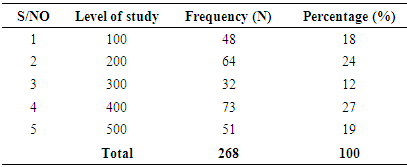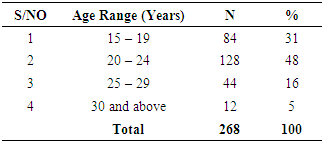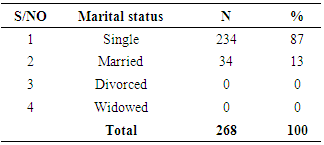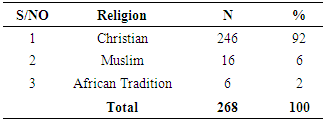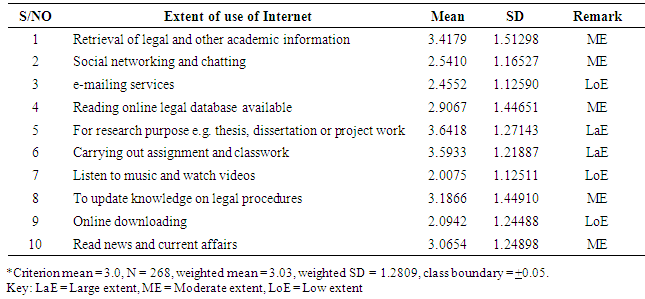-
Paper Information
- Paper Submission
-
Journal Information
- About This Journal
- Editorial Board
- Current Issue
- Archive
- Author Guidelines
- Contact Us
International Journal of Library Science
p-ISSN: 2168-488X e-ISSN: 2168-4901
2017; 6(3): 43-51
doi:10.5923/j.library.20170603.01

e-Library Use and Information Behaviour of Undergraduate Law Students in Delta State University, Oleh
Emo Okpidi Urhibo
Law Library, Delta State University, Oleh Campus, Nigeria
Correspondence to: Emo Okpidi Urhibo, Law Library, Delta State University, Oleh Campus, Nigeria.
| Email: |  |
Copyright © 2017 Scientific & Academic Publishing. All Rights Reserved.
This work is licensed under the Creative Commons Attribution International License (CC BY).
http://creativecommons.org/licenses/by/4.0/

The information behaviour of undergraduate law students was studied using a descriptive survey design with the aid of a self-structured, validated and reliable questionnaire as a tool for data collection. The population of the study consist of all undergraduates law students in the Delta State University Faculty of Law Oleh Campus, Nigeria where a sample of 315 students were randomly selected from all levels of study. A reliability coefficient of 0.78 using the Cronbach Alpha (α) was obtained. Results from the study revealed that the main purpose of the use of e-library Internet includes research, retrieval of legal information and to gain access to online law database. The range of the extent of use was from moderate to large and this was done most of the time. Google, Internet archive and database, and Yahoo were the most preferred information search strategies. The most influential factors to the use of the e-library Internet were the personal ownership of e-gadgets and non-availability of online learning/discussion for legal art. Lack of information literacy, ICT facility operational skills and impatience due to slow network connectivity were the most important constraints encountered by e-library users. The tested hypotheses showed that there was a positive relationship amongst frequency, extent and factors influencing use of Internet and a negative relationship for constraints with aforementioned factors which may have contributed to a reduction in use extent. Four percent influence of the constraints on the use of the e-library Internet resource was recorded. Recommendations were put forward also following findings.
Keywords: e-Library, Internet accessibility, Use, Information behaviour, Law, Undergraduates
Cite this paper: Emo Okpidi Urhibo, e-Library Use and Information Behaviour of Undergraduate Law Students in Delta State University, Oleh, International Journal of Library Science, Vol. 6 No. 3, 2017, pp. 43-51. doi: 10.5923/j.library.20170603.01.
Article Outline
1. Introduction
1.1. Background of the Study
- The e-library provides a wide range of products and services to its clienteles spanning across several fields of disciplines. It is a 21st century quick-access tool for information and a major essence of the utilization of libraries in institutions of learning and research. Candela in Akpoghome and Idiegbeyan (2010) said the e-library takes a central place in information provision. It is a host for Internet access, information retrieval, data management amongst others. Basically, intellectual academic research is carried out in the e-library. Its importance in the repository, retrieval and use of information is vital to the practice of law in schools. As opposed to print media repository in an academic library, the e-library sometimes called the virtual library is a repository of digital forms of information for consumption by its users. The e-library in law faculties is the store house of a large amount of legal reports, legal databases, and online law journals among others. Information plays a very vital and crucial role in the academics for the undergraduates. Information search is carried out towards satisfaction of physiological and affective needs which may be most relevant to learning by students (Wilson, 2006). Nadzir (2015) said variations occur in information behaviour among information seekers according to the specifications in information needs and the kind of perceived information gap which exists within. Undergraduates in Nigerian Universities have a lot of need for information for their learning (Okoh & Ijiekhuamhen, 2014) which influences their information behaviours. Information behaviour is defined as the totality of human behaviours in relation to the sources and channels of information, (both active and passive information seeking) and information use. Thus, it includes the face-to-face communication with others, as well as the passive reception of information as in, for example, watching TV advertisements, without any intention to act on the information given (Wilson, 2000). The Internet is seen today as one most powerful tool for information storage and retrieval which can be accessed in a click. Otolo (2016) posited that the Internet which is one major tool for globalization had influenced the use and seeking of information in libraries, indicating that information behaviour has been impacted by the use of the Internet. A range of commercial information sources in public domains is readily available on the Internet including discussion forums, bibliographical databases, preprints, journals, technical reports, biographies, directories, teaching/training materials, data archives and library catalogues (Remy and Vijayakumar, 2015).It is of utmost importance that the accessibility and utilization of e-libraries be reviewed. Legal professionals who are actively involved in the salvaging of the human race and law undergraduates who will be inducted into the bar require a repository of a pool of legal information in both print and non-print forms. A lot of research is needed to improve law undergraduates to be acquainted with the procedures involved and most especially in the practice of international law. Much is expected to be known in foreign legal practices, and thus, accessibility to available information in the e-library content via the Internet is crucial in this context of the learning process. The access to update information of legal kind within and around the globe is essential in teaching and learning of law. Therefore, an extensive examination of the information behaviour of law students can be necessitated.
1.2. Historical Background of Delta State University
- The Delta State University, Oleh is the one of the campuses of the state-government owned university whose main campus is located in Abraka and Anwai-Asaba of the state. It is popularly referred to as DELSU and currently has a student population of over 30,000. The university offers degree, diploma and certificate programmes in various disciplines with a student/staff counselling centre and several e-learning centres of which one is located in the Oleh campus where the study was carried out. The Oleh campus hosts the faculties of Law and Engineering while others faculties are spread across the two other campuses. The institution is accredited by the National University Commission (NUC), Abuja, Nigeria. Historically, the university stated as a Centre for Education, for the training of teachers, then became a College of Education from 1971 – 1981, and subsequently as a Faculty of Education under the then Bendel State University, Ekpoma and in 1992 it was inaugurated as an independent institute of learning. The e-Library was set up in Oleh to support teaching and learning.
1.3. Objectives of the Study
- The study set out to determine the impact of the use of the Internet resource available at the e library of the Faculty of Law at the Delta State University, Oleh, However, specifically, the study tends to find out the following;1. Purpose of use of e-library Internet.2. Extent of information search using the Internet resource in the e-library3. Frequency of use of e-library Internet4. Factors influencing use of e-library5. Constraints on the use of Internet resource at the e-library6. Strategies employed to seek for information on the Internet.
1.4. Research Question
- RQ1: What is the information behaviour of undergraduate law students with respect to their use of Internet in the e-library?RQ2: How do the constraints to use influence the use of Internet in the e-library?RQ3: Do constraints to use of the Internet contribute to the extent, frequency and influential factors of use?
1.5. Hypothesis
- HO1: There is no significant relationship among extent, frequency and constraints to use of Internet resource in e-library in Delta State University, Oleh.
2. Literature Review
2.1. Conceptualizing Information Behaviour among Students
- Rowley and Urquhart (2007) asserted that the students’ information behaviour is quite diffusing and it is difficult to draw conclusions. However, two main aspects are relevant to the study of information behaviours; patterns of use of information resources and attitudinal responses that follow the use which is judged behaviourally. They revealed that information behaviour focuses on three central points as listed below 1. Information seeking and searching;2. Examining disciplinary differences in information seeking and usage, and 3. Looking at information behaviour in a wider context that often includes learning and teaching.Bates (2010) referred to information behaviour as a terminology used in many ways in which humans interact with information. These include patterns for which information is sought and utilized. It is an art in the library and information science that seeks to understand the relationship between humans and information (Savolainen, 2007). These behaviours include information seeking and gathering as well as information needs and use. Case (2006; 2007) reported that information behaviour clearly describes how humans seek, manage, need, give and use information at their disposal at the different contextual basis. It can be described hence as information-seeking or human information behaviour concisely (Fisher et al., 2005).Although, the idea of information behaviour was coined during the late 1990s, its root can be traced back to the concept of information need and/or use which arose during the 1960s. Thus, information behaviour encompasses intentional and unintentional information seeking. Information seeking has been defined as a conscious effort to acquire a particular information in an attempt to fill a perceived knowledge gap while information need is the recognition that one’s knowledge is inadequate to satisfy a particular goal (Case, 2007).
2.2. Internet use by Undergraduates in Universities
- Saleh and Large (2011) said students prefer to approach other people as information channels to guide them to relevant information that is appropriate to the project task. However, several studies have revealed that apart from just meeting people, the Internet is the most visited for information needs. Okon (2010) reported the accessibility of the Internet by undergraduates in three Nigerian Universities. The extent and level of access to the Internet were investigated using a questionnaire survey in the Universities of Calabar and Uyo and the Rivers State University of Science and Technology, Port-Harcourt. Findings revealed that the Internet is extensively utilized, although there was an inequitable access as some undergraduates relied on commercial or private cybercafé. Otunla (2013) study examined the access and use of Internet among undergraduate students of Bowen University Iwo, Osun state, Nigeria revealed that all respondents accessed the Internet through their mobile phones and from the University Digital Centre. None was found to be using the library Internet facilities. Respondent used the Internet for academic purpose. Constraints identified included slow Internet connectivity, non-availability of Internet connectivity, slow downloading and regular breaking down of Internet services on campus. Aminu (2014) investigated the Internet search pattern of students and found that female undergraduates of the Ahmadu Bello University, Zaria use Google and Yahoo as their major search engines. On the other hand some use social networks for sending and retrieval of information from the Internet. A very low patronage was recorded for other search engines like Alvista, Directires, Ask.com and Dogpile. However, the most frequently used ones indicated limitations in knowledge and skills for other search engines. The lack of appropriate search skills for information hindered their use of the Internet. He found that the availability of electronic gadgets like i-pods, pads, mobile phones, and other communication devices including WiFi/Hotspots networks and cybercafés within localities influences use of Internet within the university premises. Adekunmisi et al. (2013) survey of Olabisi Onabanjo University revealed that students can spend 1 – 2 hours daily on the Internet carrying out research and other academic works. Eighty-five percent of the undergraduates asserted that slow and irregular Internet connectivity which delays downloading of relevant materials and 26.5% claimed that slow Internet access speed and poor computer skills are factors influencing the use of the Internet. Odede and Enakerakpo (2014) in their study using 237 library and information science students from Delta and Edo States of Nigeria revealed that acquisition of ICT skills among undergraduate students influence their extent of use of the Internet. The results revealed that the purpose of use of Internet includes, sending e-mails, chatting, downloading of documents, browsing, reading online, paying for school fees and doing course registration on the Internet.
2.3. Information Behaviour of Undergraduate Students
- Shakeel-Ahmed and Vinayagamoorthy (2013) examined the information behaviour of students in a business school at the academic city of Dubai, United Arab Emirates in an attempt to determine the sources consulted and the students’ pattern of gathering information using a descriptive survey. Data were collected using a structured-questionnaire administered to 2003 students randomly selected from 18 universities and colleges. Their findings showed that academic related information was the main reason for the need of information; Internet resources and/or electronic resources are the most relevant source of the academic information. Nadzir (2015) asserted that having computing skills is relevant in students’ course and with the emergence of the recent information technology, the access to information has been much easier. He investigated the use of information in a School of Computing at the University of Utara, Malaysia with the aim of finding out their information behaviour. Using a sample of 170 undergraduates with a self-structured questionnaire, found that academic information was the most searched after for the completion of academic tasks. Google search was the most used search engine. Baro et al. (2010) in their study of undergraduates in humanities of three universities, using observational, interview and questionnaires to retrieve information found that students use information sources like journals, the Internet, textbooks and humans as a primary source of information. Some of the most preferred search strategies include starting, browsing, chaining, differentiating, extracting, and monitoring.Ajiboye and Tella (2007) set out to examine the information seeking behaviour of undergraduates at the University of Botswana, Gaborone, in an attempt to find out the sources consulted and the patterns of gathering information using 2000 students from six faculties. Results from the study revealed that academic information is the most sort after and the Internet was the predominant search strategy used. The study of Okoh and Ijiekhuamhen (2014) investigated the information seeking behaviour of undergraduate students of the Federal University of Petroleum Resources (FUPRE), Ogbomorun. The findings revealed that the respondents used print media, google, library materials and social media as a major resources of research. Their constraints included lack of computer skills, lack of relevant search skills, and irregular electricity supply as factors affecting information seeking behaviour.Chaura (2015) revealed from his investigation of 254 final year students of the Mzuzu University, Malawi that most of them relied heavily on the Internet (64.6%) as their source of information, whilst 56.2% used search engines like Google, and the OPAC (45%). When searching for information, the majority of students did not use truncation (98.3%) or Boolean logic (98.8%).
3. Methodology
- This study employed a descriptive survey design, with a self-structured, validated and reliable questionnaire as a tool for data collection. The structured questionnaire was drafted after reviewing the literature with the aim of answering research questions. The population of the study consisted of all 523 undergraduate law students in the Delta State University, Oleh Campus and a sample of 315 students (60% of the population) was randomly selected from all the levels of study. A reliability coefficient of 0.78 using the Cronbach Alpha (α) was obtained using 20 undergraduate students of Engineering Faculty in the same institution. Data was collected offline within two weeks period in the months of March, 2017 by administering the questionnaire by hand to respondents. The 268 (85.2%) return were found useful for further analysis using the IBM SPSS Version 22.0 software.
4. Results and Discussion
- This section presents the results of the data collected and analysed. It discusses the personal information of the respondents and the inferential statistical analysis which focuses on the research questions and hypothesis set for the study.Demographic Data of RespondentTables 1 – 5 showed the personal information of respondents. From the data analysed for demographic characteristics, 48 (18%) of the respondents was in their first year (100 level) in undergraduate studies, while 64 (24%) were in second year (200 level), 32(12%) third year (300 level), 73(27%) of respondents in fourth year (400 level) and 51 (19%) in final year (500 level). Results showed that majority of the respondent were in the pen-ultimate year (400 level) in school (Table 1). The female respondents were found to be more in number (N = 160, 60%) than the male counterpart (N = 108, 40%) (Table 2). The age-wise distribution showed that 84 (31%) of the respondents were between 15 and 19 years of age affirming majority, 44 (16%) were between 25 to 29 years of age while 12 (5%) were 30 years and above which were a minority (Table 3). In Table 4, a vast number of respondents were found to be single (N = 234, 87%) while the others were married (N = 34, 13%). The religious distribution in Table 5 showed that 92% (N = 246) of the respondents were Christians owing to the fact that the region is Christian dominated. 16 (6%) were Muslims with only a 2% of the African Traditional religion which is a collective term for the indigenous religion or worship system.
|
|
|
|
|
|
|
 | Figure 1. Frequency of use of e-Library Internet resource |
|
|
|
|
|
5. Recommendations
- The following recommendations were made from the study;1. The e-library Internet resource utilization training and skill acquisition should be part of the learning curriculum of law undergraduates 2. Regular information technology using orientation programmes should be organized by parent institutions and allied bodies so that users can improve the proficiency of their Internet use. 3. Since the Internet is one of the most preferred sources of information search by undergraduates, more computers with update specifications should be installed to improve patronage.
6. Conclusions
- Undoubtedly, the e-library provides information services to students from all works of life. It is important to note that the operational conditions should be favourable to users. Law students in training require a wide range of information for the development of self in the procedures involved in the practice of law. It is expedient that their behaviour toward the use of information is noted. This may have implications for the use of the library and the e-library in context. The use of the Internet is very relevant for study; hence, the e-library must provide a conducive environment for its use if it must function at capacity.
Originality / Value
- The paper will be very useful for those in the decision‐making process as it reveals the need for the provision of relevant Internet infrastructural facilities in Delta State University to enhance equitable and sustainable access to the Internet by the students who use the e-library to support their learning of law in the faculty and other academic activities. It will also inform relevant authorities on the functionality of the e-library and its impact on the information behaviour of undergraduate law students to enable them to figure out necessary actions to be taken to improve the services provided by the e-library in schools generally.
ACKNOWLEDGEMENTS
- The author is most grateful to Mr Sylvester Onoriode Obigba for the technical assistance and data analysis for this manuscript. Thecontributions of Dr (Mrs) Patience Uzezi Otolo for proof reading the manuscript is highly appreciated. Also the author deeply appreciates the efforts of Mr E. Urhibo, her lovely husband for his understanding and her father, Dr Theophilus James Okpidi for the financial aid and moral support to the research.
 Abstract
Abstract Reference
Reference Full-Text PDF
Full-Text PDF Full-text HTML
Full-text HTML